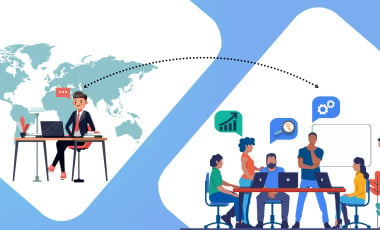Web 3.0: Explained with Real-World Examples
The internet can be considered one of the most significant technological revolutions. It began from being a medium for people to meet, read and write to a medium where people can interact, create and view content via videos or photos. But this is not where the internet stopped growing. It is still growing, trying to include Artificial Intelligence (AI), Virtual Reality (VR), and more.
It is where Web 3.0 comes into the picture. But what exactly is Web 3.0, and How is it Different from Web 2.0 and Web 1.0? Let's Find out.
Definition
Web 3.0 is the upcoming third generation of the web, where websites and applications will be built upon the core concepts of openness, decentralisation, and greater user utility. In a more straightforward explanation, the applications and websites will be able to process any form of information in a human-like way via technologies like AI, machine learning, decentralised ledger technology, and big data1 . It would also use the blockchain security system to keep the data safe and secure.
Before we get into more details, let's understand how we reached Web 3.0
Evolution of Web 3.0
Web 1.0
Web 1.0 or the Static Web was started in 1989 by Tim Berners-Lee and remained active till 2005. The primary purpose of Web 1.0 was to find information. It offered limited information with little or no user interaction, as during this period, commenting on articles or creating user pages wasn't a thing. It didn't offer algorithms to change or shift internet pages making it difficult for users to find relevant information.
However, during the mid-1990s, the first successful web browser 'Netscape Navigator' emerged2 . It had features like displaying a web page as it loads, using cookies to keep sessions informed, and using Javascript to create forms and interactive content. These features are still used today, but Microsoft later annihilated Netscape Navigator.
Web 2.0
The term Web 2.0 was first coined by Darcy DiNucci in 1999 in her article "Fragmented Future" and was later popularised in 2004 by Dale Dougherty and Tim O'Riley3 . Web 2.0 or Social Web also refers to the paradigm shift in the use of the internet. This phase of the internet was more interactive because of the advancements in web technologies like HTML5, Javascript, CSS3, etc.
It was the time when people were starting to interact and engage with each other through content blogs, social media platforms, and other services. It was also when smartphones were created, and mobile computing was launched. It paved the path for user-generated content and social media to flourish as sharing data had become easier. This era gave birth to companies like YouTube, Netflix, and Amazon, which are among the world's biggest companies today.
Web 3.0
The term was initially coined in 2006 by John Markoff, a reporter for the New York Times4 . But, one can say that it was during the end of 2012 that people started to be aware of Web 3.0. People began to notice that companies like Google, Meta, and Amazon were gaining benefits from their data. It raised the question of web safety and presented a threat to democracy.
Web 3.0 surpasses the expectations of the Semantic Web. In many ways, Web 3.0 is a return of Semantic Web, a concept by Tim Berners-Lee5 . It was earlier thought that Semantic Web would be the next generation of the internet. But the basic idea of having a decentralised and open internet is back with Web 3.0.
Now that we are talking about decentralisation let's dive deeper into it.
Web 3.0, Blockchain and Decentralisation
Blockchain is hard to understand but to explain it simply, blockchain is more like a set of connected blocks, where every block consists of a group of transactions verified by all the members of the network. The individual blocks are linked to a chain of previous cryptocurrency transactions. You can consider blockchain as an account book where you are writing all of your expenses. Each page is like a block, and the entire book will become a blockchain.
Web 3.0 will be built on the core concept of decentralisation and will use the founding blocks of blockchain technology that undergirds Bitcoin and other cryptocurrencies. It will use blockchains to store the content making it decentralised6 . It will create a transparent and secure environment.
For example, you decide to go to a known hospital chain for a health check-up. They have your details, including the result of the check-ups. Today, these hospitals have control over the data. They can decide to share it with other pharmaceutical companies or use it themselves. But, with Web 3.0, you will have access to the data, and only you can decide if you want to share it with any other organisation or person.
It will give the users more power and take away control from the hands of Internet giants like Google or Meta (Facebook), which are currently making enormous profits with their massive database.
Advantages of Web 3.0
As mentioned earlier, Web 3.0 will make the internet secure, transparent, and intelligent, making browsing more efficient and machine-human interaction more effective. But let's understand what the other advantages of Web 3.0 are.
1. Data Privacy and Control
Blockchain and data encryption will help users protect their information and prevent large organisations from controlling and using users' data for their interests. It will give users complete ownership over their data.
2. Seamless Service
With decentralised data, users can access the information anywhere in the world under any circumstance with multiple backups. Additionally, no government organisation will have control over this data.
3. Transparency
Blockchain allows users to track their data and inspect the codes behind the platform. As many nonprofits develop blockchain platforms, they will be in a situation to use open-source platforms that allow their designs, codes and development information to be open. It will ensure that the users don't have to depend on an individual or organisation that develops the platform.
4. Restrictionless Platforms
As all can access the blockchain network, you can create your address or interact with the network. It will also enable users to transfer their wealth or assets anywhere. Users can be restricted based on income, location, gender, or sociological factors.
5. Single Profile Creation
Users will only have to create a single profile that can be used to access any platform, and it will also allow them to have complete ownership of any given information. Users can also share or sell their data to other advertisers or brands.
6. Enhanced Data Processing
Web 3.0 uses AI to filter information from a vast data set, making it easier to do intensive knowledge creation tasks. You can also personalise customer service, manage data, or even conduct client demand forecasting.
Pitfalls of Web 3.0
1. Requires Advance Devices
Web 3.0 can not be accessed with less advanced computers as the device's features will need to be extended to make the technology more globally reachable. Today, a minimal number of people will be able to access Web 3.0. The technology is also not ready for widespread use as more work is required to satisfy the users' needs.
2. Web 1.0 Websites will become Obsolete
If Web 3.0 becomes full-fledged on the internet, any website based on Web 1.0 will go out of date and will no longer be accessible. The old technology will not be able to update itself, meaning that it will lose a competitive edge over the newer sites.
3. Demand for Reputation Management will Increase
Reputation management will become a cause of concern as users' information will be readily available, and there will be less anonymity. To stay ahead, companies will have to maintain their image and reputation online through compelling content, critical marketing intelligence, and cutting-edge internet marketing.
4. Complicated Functionality
Web 3.0 is difficult to understand, making users hesitant to use it. They will also need to purchase new devices or update their old ones, making it an additional cost that not many individuals or organisations can afford.
5. Regulatory Risks
Cybercrime, misinformation, and hate speech are hard to manage, but they will only intensify with decentralisation. It will also make enforcement and regulation difficult.
Real-World Examples of Web 3.0
While Web 3.0 may still take time to come into full effect, a few organizations already use it. They use voice recognition, AI, blockchain, and much more. These software or tools are still in the early stage, and many improvements are to be made. A few examples of these are:
- Siri by Apple's voice recognition software7 .
- Wolfram Alpha computational intelligence platform that now uses Web 3.08 .
- Steemit is a decentralized reward platform that runs on Steem Blockchain Social Media Module. It is a perfect example of a Web 3.0 social media platform.
- Sola is a decentralized social media platform powered by IPFS, Ethereum blockchain, and distributed nodes.
- IDEX is an Ethereum-based exchange for trading ERC-20 tokens that work on Web 3.0
- e-Chat is a secure Web 3.0 messenger app powered by a decentralized blockchain.
- Storj is a decentralized storage platform.
- Everledger is a distributed digital global registry. It is a perfect example of insurance and banking on Web 3.0
- LBRY is a music and video website
- Enhance is a remote job platform on Web 3.0
Web 3.0 will give users control over their data and create a safe and transparent web. Though the adaptation of Web 3.0 will take time, this is what the future holds for us. Will you embrace the future, or will we remain hesitant?



